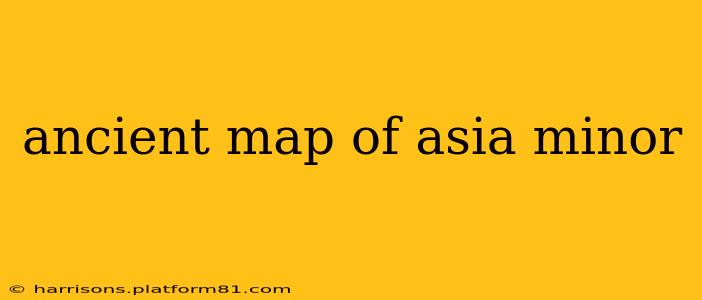Asia Minor, the historical peninsula now largely encompassing modern-day Turkey, boasts a rich and complex past reflected in its diverse ancient maps. These cartographic representations, though often imperfect by modern standards, offer invaluable glimpses into the geographical knowledge, political landscapes, and cultural perceptions of ancient civilizations. This exploration delves into the fascinating world of ancient maps of Asia Minor, examining their creation, significance, and the insights they provide into the region's history.
What are some of the oldest known maps of Asia Minor?
Pinpointing the absolute "oldest" is difficult due to the fragmentary nature of surviving evidence and varying interpretations of cartographic representation. However, some of the earliest depictions of the region can be found within larger world maps from ancient civilizations. For instance, fragments of Babylonian clay tablets dating back to the 7th century BC may contain representations of Anatolian regions, though these are often schematic and not detailed geographical maps in the modern sense. Similarly, certain sections of Ptolemaic maps (2nd century AD) provide relatively detailed depictions of Asia Minor, incorporating geographic features and settlements known at the time. These maps, while not the oldest extant examples, represent a significant advancement in cartographic techniques and provide a level of detail unmatched by earlier sources.
How accurate were ancient maps of Asia Minor?
The accuracy of ancient maps of Asia Minor varied considerably depending on the time period and the civilization producing them. Early maps were often more schematic, focusing on major geographical features and settlements rather than precise measurements or detailed topography. They relied heavily on eyewitness accounts, travelers' reports, and existing knowledge passed down through generations. Therefore, distortions and inaccuracies were common. Later maps, like those produced during the Roman and Byzantine periods, show improvements in accuracy, reflecting advances in surveying techniques and a greater understanding of the region’s geography. However, even these later maps still contained inaccuracies, particularly in areas with less accessible or less well-known terrain. It's crucial to understand that these maps are products of their time and reflect the knowledge and limitations of the societies that created them.
What information can we learn from ancient maps of Asia Minor?
Ancient maps of Asia Minor serve as invaluable sources of information for historians, geographers, and archaeologists. They reveal:
- Geographical Knowledge: The maps demonstrate the extent of geographical knowledge at different points in history, showing how perceptions and understanding of the region's features evolved over time.
- Political Boundaries: The depiction of cities, towns, and provinces reflects the political organization and control of the region under different empires and kingdoms, providing crucial insights into political power shifts.
- Trade Routes: The placement of settlements and the emphasis on certain geographical features often suggest significant trade routes and networks that connected Asia Minor to other parts of the ancient world.
- Cultural Influences: The stylistic choices and the names used on the maps reflect the cultural influences present in the region and the perspectives of those who created the maps.
By studying these maps, we gain a richer understanding of ancient societies' interactions with their environment and the development of the region's cultural and political landscape.
Where can I find examples of ancient maps of Asia Minor?
Many examples of ancient maps depicting Asia Minor are held in major museums and research libraries around the world. These institutions often have online catalogs or databases where you can find images and information about their collections. Academic journals and books specializing in ancient cartography and the history of Asia Minor also contain detailed discussions and reproductions of these valuable historical artifacts. While access to original maps may be limited, the wealth of information available through digital resources makes the study of ancient maps of Asia Minor accessible to a broader audience.
Remember that studying these maps requires careful interpretation, considering the historical context, the limitations of the cartographic techniques of the time, and the potential for bias or inaccuracies. However, when approached with a critical yet appreciative eye, these ancient maps provide fascinating insights into the past and help us better understand the history of Asia Minor.
